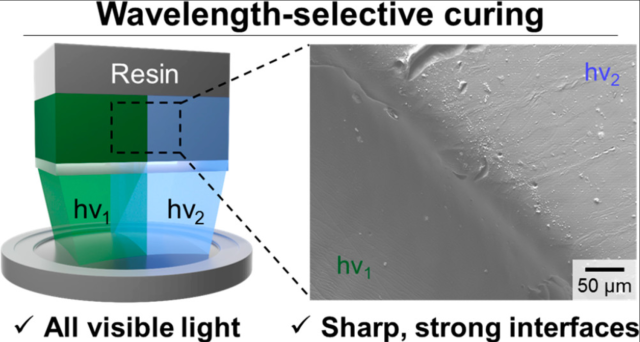
Tough Multimaterial Interfaces through Wavelength-Selective 3D Printing
Neil D. Dolinski, E. Benjamin Callaway, Caitlin S. Sample, Luke F. Gockowski, Roberto Chavez, Zachariah A. Page, Fabian Eisenreich, Stefan Hecht, Megan T. Valentine, Frank W. Zok, and Craig J. Hawker. ACS Appl. Mater. Interfaces 13(18):22065–22072 (2021).
Abstract
Strong and well-engineered interfaces between dissimilar materials are a hallmark of natural systems but have proven difficult to emulate in synthetic materials, where interfaces often act as points of failure. In this work, curing reactions that are triggered by exposure to different wavelengths of visible light are used to produce multimaterial objects with tough, well-defined interfaces between chemically distinct domains. Longer-wavelength (green) light selectively initiates acrylate-based radical polymerization, while shorter-wavelength (blue) light results in the simultaneous formation of epoxy and acrylate networks through orthogonal cationic and radical processes. The improved mechanical strength of these interfaces is hypothesized to arise from a continuous acrylate network that bridges domains. Using printed test structures, interfaces were characterized through spatial resolution of their chemical composition, localized mechanical properties, and bulk fracture strength. This wavelength-selective photocuring of interpenetrating polymer networks is a promising strategy for increasing the mechanical performance of 3D-printed objects and expanding light-based additive manufacturing technologies.